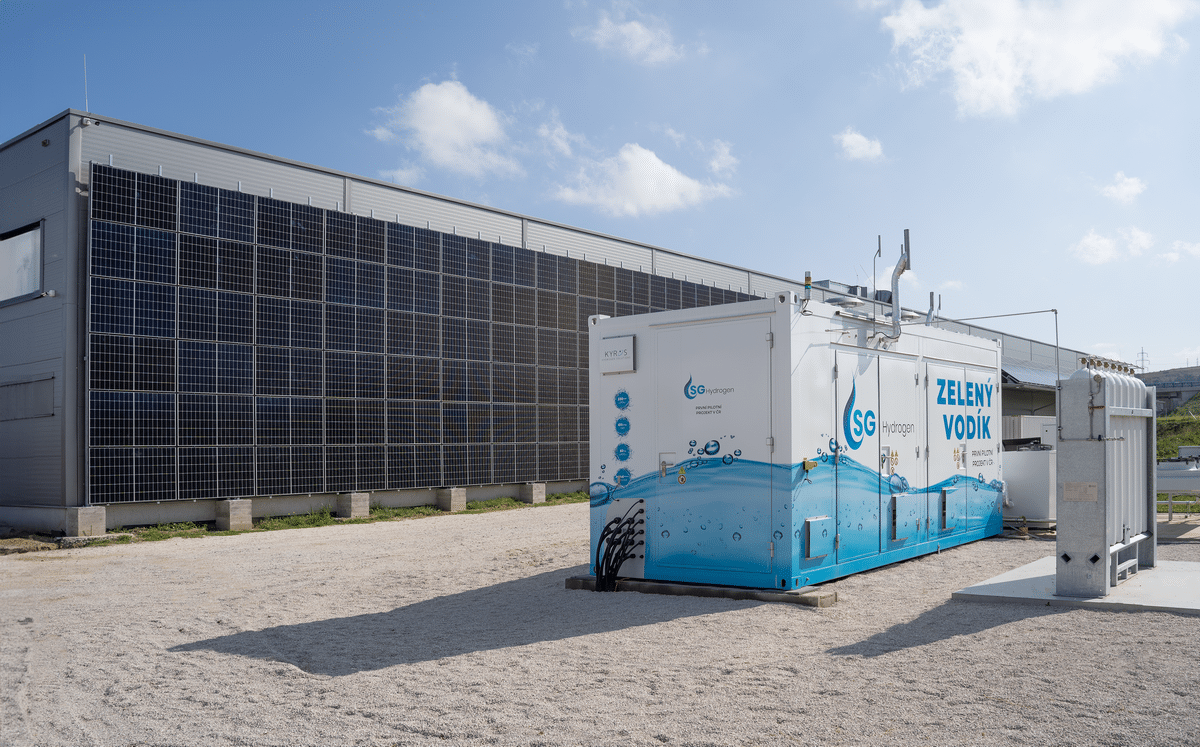Solar Global operates electrolyzer plant in Czech Republic
An electrolyzer in the town of Napajedla in southeastern Czech Republic has produced the country’s first green hydrogen from solar power. The industrial green hydrogen production facility is run by Solar Global, one of the leading companies in the Czech renewables sector.
This hydrogen plant should be seen primarily as a pioneering initiative since its capacity of 230 kilowatts is relatively low. It can consume up to 246 megawatt-hours per year of electricity. The power is sourced from a photovoltaic plant with a peak capacity of 611 kW. Battery storage is used to buffer the discrepancies between generation and consumption. In line with the Czech hydrogen strategy, most of the hydrogen ends up as fuel.
“Green hydrogen produced in this way can be used at the refueling station in Napajedla to fill up not just trucks and buses, but also cars with environmentally friendly hydrogen propulsion,” explained Vít?zslav Skopal, owner of Solar Global Group. According to Solar Global, the plant can supply around 8 metric tons (8.8 US tons) of green hydrogen. This is enough to enable a car to travel 800,000 kilometers (500,000 miles) and a hydrogen bus to travel 80,000 kilometers (50,000 miles).
Covering the entire value chain
Hydrogen production is expected to develop gradually into a major area of industry in the Czech Republic. As this happens, the Solar Global Group foresees an entire value chain developing alongside it. In addition to hydrogen production, the company has its sights set on the operation of vehicles equipped with fuel cells. Ultimately, the corporation also wants to get involved in the supply of hydrogen via refueling stations. “Of course all this depends on the building of other requisite technologies, in other words hydrogen compression, storage and refueling stations, and these are the next stages of our pilot project,” said Skopal.
The production of the country’s first kilogram of hydrogen was funded by the State Environmental Fund of the Czech Republic or SEF CR, which has been in existence since 1992. So far the environment ministry has financially supported four electrolyzers from the environment fund. “Two further projects are under examination,” stated Lucie Früblingová, spokeswoman for the state environment fund. The schemes under which hydrogen projects can receive support are currently being widened. The number of assisted projects and the amount distributed in subsidies are set to rise in the future.
Traditional producers look to green hydrogen
Among those due to receive funding is Orlen Unipetrol, the Czech Republic’s largest producer of “gray,” fossil-based hydrogen. The company, which is part of Polish petroleum giant Orlen, intends to install an electrolyzer in conjunction with a solar power plant in Litvínov. Groundwork will begin sometime between 2024 and 2025, with the production of green hydrogen slated to start at the end of 2028. However, Unipetrol is well aware that its own production can only cover a fraction of its hydrogen demand and is already considering hydrogen imports.
Another electrolyzer being aided by the environment fund belongs to the Sev.en Energy Group. The mining company operates what was once the extensive opencast brown coal mine in Most, Komo?any, which will soon be exhausted, as well as the associated coal power plants. Sev.en is planning a massive expansion in solar power plants totaling 120 MW. The proposals include a 17.5-MW electrolyzer that will manufacture 360 metric tons (400 US tons) of green hydrogen a year starting in 2027. The costs for the hydrogen system, according to Sev.en’s head of transformation Pavel Farka?, run to around CZK 700 million, which equates to EUR 28.5 million, a substantial proportion of which is to be covered by subsidies from the environment fund.
In October 2023, the Czech government presented the draft of an energy and climate plan for the years leading up to 2030. The press release from the environment ministry stated that the use of hydrogen would increase within industry and the mobility sector by the end of the decade. The plan also foresees that electricity derived from brown coal will no longer be exported.
Author: Aleksandra Fedorska
National hydrogen strategy for the Czech Republic: www.hytep.cz/images/dokumenty-ke-stazeni/Czech_Hydrogen_Strategy_2021.pdf

